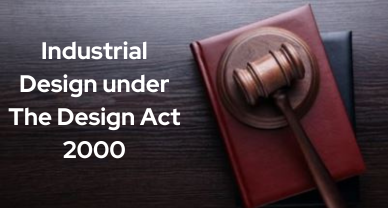Industrial Design under The Design Act, 2000
The Designs Act, 2000 (“the Act”), is a complete code in itself and protection under it is totally statutory in nature. It protects the visual design of objects that are not purely utilitarian. Section 2(d) of the Act defines a Design as:
“Design” means only the features of shape, configuration, pattern, ornament or composition of lines or colors applied to any article whether in two dimensional or three dimensional or in both forms, by any industrial process or means, whether manual, mechanical or chemical, separate or combined, which in the finished article appeal to and are judged solely by the eye; but does not include any mode or principle of construction or anything which is in substance a mere mechanical device, and does not include any trade mark as defined in clause (v) of sub-section (1) of section 2 of the Trade and Merchandise Marks Act, 1958 (43 of 1958) or property mark as defined in section 479 of the Indian Penal Code (45 of 1860) or any artistic work as defined in clause (c) of section 2 of the Copyright Act, 1957 (14 of 1957).
Designs are registered in different classes as per the Locarno Agreement. It is used to classify goods for the purposes of the registration of industrial designs which further helps in design searches. These classes are mainly function oriented. The copyright on a registered design is in total for 15 years.
Introduction
The Indian consumer now has countless possibilities for just about every single product thanks to liberalization’s influx of options. The perspective of Indian consumers as well as vendors has been altered by this development.
The sellers must satisfy the customer’s aesthetic senses in addition to their reputation for dependability and honesty in the market for them to appease the buyer, sellers are now more than ever compelled to package and market their items in a way that appeals to consumers and that consumers can relate to. Given the enormous resources and time invested by producers and marketers in building customer recognition through the presentation and appearance of their goods, it is crucial that the same is protected under law.
Protection of Design
The design sought for protection must be new or original, i.e., not disclosed to the public in India or elsewhere in the world by prior publication or by prior use or in any other way. The design should be significantly distinguishable from designs or combination of designs that are already registered or pre-existing or disclosed to the public. Furthermore, the design shall not include any scandalous or obscene matter or any feature that is purely functional in nature.
As in case of any other IP rights, the design registration also bestows the monopolistic right to the proprietor by which the right holder can legally exclude others from reproducing, manufacturing, selling, or dealing in the said registered design without consent from the proprietor.
The definition of Design under the new Act has been widened. Under the previous law, the Design registration was granted only for the visual appearance of an article which included shape, configuration pattern, and ornamentation whether in 2 or 3 dimensions. Under new law, a Design registration can now be obtained for new or original features of shape, configuration pattern, ornamentation or composition of lines or colors as applied to an article, whether in 2 or 3 dimensions or both.
A Design registration has been brought within the domain of the public records right from the date it is physically placed on the Register. Any member of public can take inspection of the records and obtain a certified copy of the entry. In the previous Act, there was a 2-year confidential period post registration, which prohibited taking inspection/certified copy of any entry in the records.
A Design registration would be valid for 10 years (from the date of registration which is also the date of application) renewable for a further period of 5 years. Under the previous law the validation period was 5 years which was extendable for 2 terms of 5 years each.
A Design registration can be restored within a year from its last date of expiry. Under the previous law, no provision relating to restoration upon expiration of the Design registration was provided.
Revocation of Design
There is no concept of a Pre-Grant Opposition in the Design law of India, like in the case of Patents law. Such a difference is based on the fact that the publication of design is done upon Registration.
Section 19 of the Indian Design Act 2000 provides for rectification of a registered design in India. A petition can be filed anytime after the registration of a design on Form 8 with the Controller General of Patents, Designs and Trademarks (CPTDM) along with the official fees of INR 1500/- on grounds provided under section 19 of The Design Act 2000.
Section 19 of the The Designs Act 2000 provides for grounds of cancellation of a registered design as under Design Act;
(1) Any person interested may present a petition for the cancellation of the registration of a design at any time after the registration of the design, to the Controller on any of the following grounds, namely;
(a) that the design has been previously registered in India; or
(b) that it has been published in India or in any other country prior to the date of registration; or
(c) that the design is not a new or original design; or
(d) that the design is not registrable under this Act: or
(e) it is not a design as defined under clause (d) of section 2.
(2) An appeal shall lie from any order of the Controller under this section to the High Court, and the Controller may at any time refer any such petition to the High Court, and the High Court shall decide any petition so referred.
Infringement of Designs under the Act
Infringement of a copyright in design is termed as “Piracy of a registered Design”. It is not lawful for any person during the existence of copyright to do the following acts without the consent or license of the registered proprietor of the design. Section 22 of the Designs Act, 2000, lays down that the following acts amount to piracy:
(1) To publish or to have it published or expose for sale any article of the class in question on which either the design or any fraudulent or obvious imitation has been applied.
(2) To either apply or cause to apply the design that is registered to any class of goods covered by the registration, the design or any imitation of it.
(3) To import for the purpose of sale any article belonging to the class in which the design has been registered and to which the design or a fraudulent or obvious imitation thereof has been applied.
In fact any unauthorized application of the registered design or a fraudulent or obvious imitation thereof to any article covered by the registration for trade purpose or the import of such articles for sale is a piracy or infringement of the copyright in the design.
Landmark Judgments
Crocs Inc. USA v. Bata India Ltd. and Ors.[1]
Facts:
In this case, Crocs filed a suit against Bata for infringement of its registered sandal designs and passing off its trademarks in the shape and configuration of its footwear. As the design registration was a prima facie liability to be canceled based on prior publication and new, the Division Bench of the Delhi High Court did not interfere with the single judge’s order denying the interim injunction to Crocs. Before filing the date of the design application, the designs were issued on the Crocs website.
Judgments
The court held that based on the previous publication the validity of design registration was questionable. It further added that the designs claimed was only modifications of pre-existing designs, the court stated that the novelty or originality of the designs was also questionable. In this case, The Delhi High Court also sustained the grant of legal costs to the defendants. Furthermore, the Court ordered the single judge to hear the passing of cases along with registered design cases as they were based on the same cause of action.
Author: Yashasvi Rai, A Student at Chanakya National Law University, Patna, in case of any queries please contact/write back to us at support@ipandlegalfilings.com or IP & Legal Filing.
[1] 2019 SCC OnLine Del 6808



